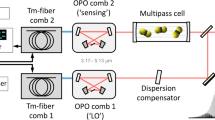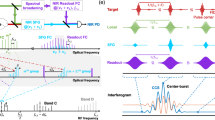Abstract
Multidimensional coherent spectroscopy (MDCS)1,2 is a powerful method that enables the measurement of homogeneous linewidths in inhomogenously broadened systems, many-body interactions and coupling between excited resonances, all of which are not simultaneously accessible by any other method. Current implementations of MDCS require a bulky apparatus and suffer from resolution and acquisition speed limitations that constrain their applications outside the laboratory3,4,5. Here, we propose and demonstrate an approach to nonlinear coherent spectroscopy that utilizes three slightly different repetition-rate frequency combs. Unlike traditional nonlinear methods, tri-comb spectroscopy uses only a single photodetector and no mechanical moving elements to enable faster acquisition times, while also providing comb resolution. As a proof of concept, a multidimensional coherent spectrum with comb cross-diagonal resolution is generated using only 365 ms of data. These improvements make MDCS relevant for systems with narrow resonances and it has the potential to be field deployable for chemical-sensing applications.
This is a preview of subscription content, access via your institution
Access options
Access Nature and 54 other Nature Portfolio journals
Get Nature+, our best-value online-access subscription
$29.99 / 30 days
cancel any time
Subscribe to this journal
Receive 12 print issues and online access
$209.00 per year
only $17.42 per issue
Buy this article
- Purchase on Springer Link
- Instant access to full article PDF
Prices may be subject to local taxes which are calculated during checkout



Similar content being viewed by others
Data availability
The data that support the plots within this paper and other findings of this study are available from the corresponding author upon reasonable request.
References
Cundiff, S. T. Coherent spectroscopy of semiconductors. Opt. Express 16, 4639–4664 (2008).
Hamm, P. & Zanni, M. Concepts and Methods of 2D Infrared Spectroscopy (Cambridge Univ. Press, New York, 2011).
Draeger, S., Roeding, S. & Brixner, T. Rapid-scan coherent 2D fluorescence spectroscopy. Opt. Express 25, 3259–3267 (2017).
Fuller, F. D., Wilcox, D. E. & Ogilvie, J. P. Pulse shaping based two-dimensional electronic spectroscopy in a background free geometry. Opt. Express 22, 1018–1027 (2014).
Harel, E., Fidler, A. F. & Engel, G. S. Real-time mapping of electronic structure with single-shot two-dimensional electronic spectroscopy. Proc. Natl Acad. Sci. USA 107, 16444–16447 (2010).
Coddington, I., Newbury, N. & Swann, W. Dual-comb spectroscopy. Optica 3, 414–426 (2016).
Coddington, I., Swann, W. C. & Newbury, N. R. Coherent multiheterodyne spectroscopy using stabilized optical frequency combs. Phys. Rev. Lett. 100, 013902 (2008).
Kippenberg, T. J., Holzwarth, R. & Diddams, S. A. Microresonator-based optical frequency combs. Science 332, 555–559 (2011).
Suh, M.-G., Yang, Q.-F., Yang, K. Y., Yi, X. & Vahala, K. J. Microresonator soliton dual-comb spectroscopy. Science 354, 600–603 (2016).
Yu, M. et al. Silicon-chip-based mid-infrared dual-comb spectroscopy. Nat. Commun. 9, 1869 (2018).
Baumann, E. et al. Spectroscopy of the methane with an accurate midinfrared coherent dual-comb spectrometer. Phys. Rev. A 84, 062513 (2011).
Bernhardt, B. et al. Cavity-enhanced dual-comb spectroscopy. Nat. Photon. 4, 55–57 (2010).
Boudreau, S., Levasseur, S., Perilla, C., Roy, S. & Genest, J. Chemical detection with hyperspectral lidar using dual frequency combs. Opt. Express 21, 7411–7418 (2013).
Brehm, M., Schliesser, A. & Keilmann, F. Spectroscopic near-field microscopy using frequency combs in the mid-infrared. Opt. Express 14, 11222–11233 (2006).
Trocha, P. et al. Ultrafast optical ranging using microresonator soliton frequency combs. Science 359, 887–891 (2018).
Suh, M.-G. & Vahala, K. J. Soliton microcomb range measurement. Science 359, 884–887 (2018).
Lomsadze, B. & Cundiff, S. T. Frequency combs enable rapid and high-resolution multidimensional coherent spectroscopy. Science 357, 1389–1391 (2017).
Cundiff, S. T. Optical two-dimensional Fourier transform spectroscopy of semiconductor nanostructures [Invited]. J. Opt. Soc. Am. B 29, A69–A81 (2012).
Kurnit, N. A., Abella, I. D. & Hartmann, S. R. Observation of a photon echo. Phys. Rev. Lett. 13, 567–568 (1964).
Boyd, R. W. Nonlinear Optics 3rd edn (Academic Press, New York, 2008).
Tekavec, P. F., Lott, G. A. & Marcus, A. H. Fluorescence-detected two-dimensional electronic coherence spectroscopy by acousto-optic phase modulation. J. Chem. Phys. 127, 214307 (2007).
Lomsadze, B. & Cundiff, S. T. Multi-heterodyne two dimensional coherent spectroscopy using frequency combs. Sci. Rep. 7, 14018 (2017).
Asahara, A. & Minoshima, K. Development of ultrafast time-resolved dual-comb spectroscopy. APL Photon. 2, 041301 (2017).
Lomsadze, B. & Cundiff, S. T. Frequency-comb based double-quantum two-dimensional spectrum identifies collective hyperfine resonances in atomic vapor induced by dipole–dipole interactions. Phys. Rev. Lett. 120, 233401 (2018).
Lomsadze, B. & Cundiff, S. T. Frequency comb-based four-wave-mixing spectroscopy. Opt. Lett. 42, 2346–2349 (2017).
Siemens, M. E., Moody, G., Li, H., Bristow, A. D. & Cundiff, S. T. Resonance lineshapes in two-dimensional Fourier transform spectroscopy. Opt. Express 18, 17699–17708 (2010).
Sinclair, L. C. et al. Invited article: a compact optically coherent fiber frequency comb. Rev. Sci. Instrum. 86, 081301 (2015).
Zhao, X. et al. Dead-band-free, high-resolution microwave frequency measurement using a free-running triple-comb fiber laser. IEEE J. Sel. Top. Quantum Electron. 24, 1–8 (2018).
Lucas, E. et al. Spatial multiplexing of soliton microcombs. Nat. Photon. https://doi.org/10.1038/s41566-018-0256-7 (2018).
Acknowledgements
The research is based on work supported by the Office of the Director of National Intelligence (ODNI), Intelligence Advanced Research Projects Activity (IARPA), via contract 2018-18020600001. The views and conclusions contained herein are those of the authors and should not be interpreted as necessarily representing the official policies or endorsements, either expressed or implied, of the ODNI, IARPA or the US government. B.C.S. acknowledges support by the National Science Foundation through a Graduate Research Fellowship (1256260).
Author information
Authors and Affiliations
Contributions
B.L. and S.T.C. conceived the concept. B.L. and B.C.S. ran the experiment and took the data. B.L. analysed the results and wrote the manuscript. All authors discussed the results and commented on the manuscript at all stages.
Corresponding author
Ethics declarations
Competing interests
B.L. and S.T.C. are coinventors on patent application 15/705511 submitted by the University of Michigan that covers ‘Frequency comb-based multidimensional coherent spectroscopy’.
Additional information
Publisher’s note: Springer Nature remains neutral with regard to jurisdictional claims in published maps and institutional affiliations.
Supplementary information
Supplementary Information
This file contains supplementary figures and additional information about the work.
Rights and permissions
About this article
Cite this article
Lomsadze, B., Smith, B.C. & Cundiff, S.T. Tri-comb spectroscopy. Nature Photon 12, 676–680 (2018). https://doi.org/10.1038/s41566-018-0267-4
Received:
Accepted:
Published:
Issue Date:
DOI: https://doi.org/10.1038/s41566-018-0267-4
This article is cited by
-
All-fiber frequency agile triple-frequency comb light source
Nature Communications (2023)
-
Dual-comb optical activity spectroscopy for the analysis of vibrational optical activity induced by external magnetic field
Nature Communications (2023)
-
Generation of dual and quad-optical frequency combs in the injected radiation free mode-locked frequency-shifted feedback laser
Frontiers of Optoelectronics (2023)
-
Dual chirped microcomb based parallel ranging at megapixel-line rates
Nature Communications (2022)
-
The time-programmable frequency comb and its use in quantum-limited ranging
Nature (2022)



